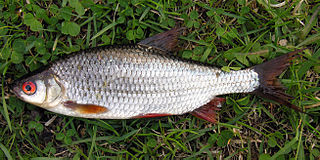
Toxorhynchites, also called elephant mosquito or mosquito eater, is a genus of diurnal and often relatively colorful mosquitoes, found worldwide between about 35° north and 35° south. Most species occur in forests. It includes the largest known species of mosquito, at up to 18 mm (0.71 in) in length and 24 mm (0.94 in) in wingspan. It is among the many kinds of mosquito that do not consume blood. The adults subsist on carbohydrate-rich materials, such as honeydew, or saps and juices from damaged plants, refuse, fruit, and nectar.

The Talladega National Forest is located in the U.S. state of Alabama and covers 392,567 acres at the southern edge of the Appalachian Mountains.

Osteopilus is a genus of frogs in the family Hylidae. These species have a bony co-ossification on the skull resulting in a casque, hence its name ‘bone-cap’, from osteo- (‘bone’) and the Greek pilos. Color varies between uniform brown, brown-gray, or olive with darker markings or marbled with greens, grays or brown, making a distinct pattern. The finger disks are round; the fingers with a reduced webbing; eyes and tympanum are large. Their natural range includes the Greater Antilles and the Bahamas, but O. septentrionalis has also been introduced to the Lesser Antilles, Hawaii and Florida (USA).

The streaked xenops is a passerine bird in the Furnariinae subfamily of the ovenbird family Furnariidae. It is found in the New World from Costa Rica and Trinidad south to Bolivia and Argentina.

The roach, or rutilus roach, also known as the common roach, is a fresh- and brackish-water fish of the family Cyprinidae, native to most of Europe and western Asia. Fish called roach can be any species of the genera Rutilus and Hesperoleucus, depending on locality. The plural of the term is also roach.

Climacodon septentrionalis, commonly known as the northern tooth fungus or the white rot fungus, is a species of shelf fungus in the phylum Basidiomycota. It is white in color and can be found in large clusters on the trunks of trees. This species is a plant pathogen native to North America.
Oecomys rutilus, also known as the reddish oecomys or red arboreal rice rat, is a species of rodent in the genus Oecomys of family Cricetidae. It is found in Guyana, Suriname, French Guiana, and nearby regions of Brazil and Venezuela.

Rutilus frisii, called the vyrezub, Black Sea roach, or kutum, is a species of fish in the family Cyprinidae, native to the basins of the Black Sea, Sea of Azov, and Sea of Marmara from the rivers of Bulgaria to western Transcaucasia and in Lake Iznik (Turkey).

The Torotoroka scops owl is a subspecies of owl in the family Strigidae. It is endemic to the western parts of Madagascar, and was previously regarded as its own species. However, O. madagascariensis and the rainforest scops owl Otus rutilus have now been re-lumped following Fuchs et al. (2007) as the Madagascar scops owl or Malagasy scops owl. Therefore this taxon now becomes a subspecies, Otus rutilus madagascariensis.

Epomophorus is a genus of bat in the family Pteropodidae. They have a distribution throughout Africa.

Van Sung's shrew, also known as Cao Van Sung mountain shrew is a species of shrew in the Soricomorpha order. Specimens of Chodsigoa caovansunga have been found in Vietnam.
Polyptychoides septentrionalis is a moth of the family Sphingidae. It is known from Kenya.

The Caspian roach is a species of roach fish living in the Caspian Sea. The Caspian roach can be distinguished from other roaches by its laterally compressed body, silvery grey iris, rounded snout and grey pectoral pelvic and anal fins with dark margins. The Caspian roach is semi-anadromous and inhabits mostly shallow coastal waters. It enters Volga, Ural, Emba, Terek and Kura drainages for spawning.

Toxorhynchites rutilus, also known as the elephant mosquito or treehole predatory mosquito, is a species of mosquito in the family Culicidae. Unlike most species in the genus that populate the tropics, Tx. rutilus is endemic to temperate regions. As their name suggests, these mosquitoes commonly lay their eggs in treeholes where their larvae are predators on a variety of arthropods. As with other mosquitoes, they also inhabit other bodies of stagnant water such as in a tire or artificial containers. but not large bodies of water like ponds and ground pools. Females are able to strategically locate breeding sites that already contain prey to oviposit in.

Onitis alexis, the bronze dung beetle, is a species of dung beetle in the family Scarabaeidae. It is endemic to Africa, Syria, Spain, Tunisia and Greece. It was introduced into Australia and is established in the warmer regions of northern Australia. The species is found in Oceania.
Neonympha helicta, the helicta satyr, is a species of brush-footed butterfly in the family Nymphalidae. It is found in North America. There is some question that this putative species is the same as that figured by Jacob Hübner as Oreas helicta

Ciliata septentrionalis is a species of fish belonging to the family Lotidae.
Anurophorus is a genus of Collembola belonging to the family Isotomidae.
Craesus is a genus of insects belonging to the family Tenthredinidae.

Dolichopoda azami, the Azam's cave-cricket, is a species of cave cricket within the family Rhaphidophoridae. The species distribution is in France in the Southern Alps and in Italy in Piedmont, Liguria and Lombardia, where it lives in various dark habitats that have stable temperatures and high humidity. Such habitats include rocky forests, caves, damaged bridges or aqueducts, and abandoned/disused buildings at elevations of 120 to 1,940 metres. It lives in these habitats during the day and is primarily active at night.















